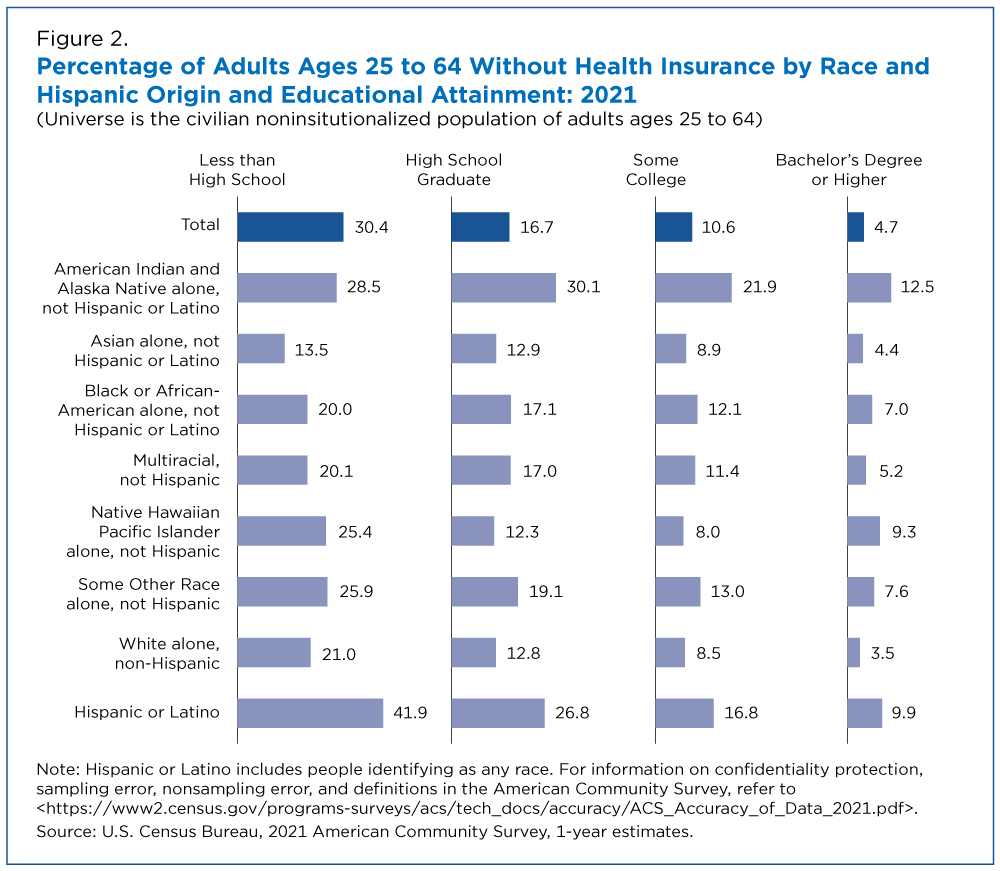Differences in Uninsured Rates by Race and Ethnicity Persist Even Among Those With Higher Educational Attainment
Research has shown that uninsured rates are lower for people with more education but an analysis of U.S. Census Bureau data shows that racial and ethnic disparities in health insurance coverage persist even among the more educated.
A recent brief that uses data from the 2021 American Community Survey (ACS) showed that the uninsured rate across race and Hispanic origin groups ranged from 5.7% for White, non-Hispanic people to 18.8% for those identifying as non-Hispanic American Indian and Alaska Native.
Those without a high school diploma had among the highest uninsured rates within each race and Hispanic origin group and those holding a bachelor’s degree had the lowest.
The ACS 1-year estimates show that educational attainment varied widely by race and Hispanic origin (Figure 1). For example, about 60% of Asian, non-Hispanic adults ages 25 to 64 held a bachelor’s degree or higher compared with 16.5% of non-Hispanic American Indian and Alaska Native adults in that age group.
Other race groups with high rates of people with at least a bachelor’s degree included: Some Other Race, non-Hispanic (42.3%), and White, non-Hispanic (41.5%).
Uninsured Rates by Educational Attainment
In 2021, 11.9% of adults ages 25 to 64 years did not have health insurance coverage. However, the uninsured rate varied by educational attainment, ranging from 30.4% among those with less than a high school education to 4.7% among those with a bachelor’s degree or higher.
The uninsured rate of those with a bachelor’s degree or higher was lower than the national average of 11.9%.
There were also differences in the uninsured rate by educational attainment between and within race and Hispanic origin groups.
Those without a high school diploma had among the highest uninsured rates within each race and Hispanic origin group and those holding a bachelor’s degree had the lowest.
Among those with a bachelor’s degree, adults ages 25 to 64 years in most race and Hispanic origin groups — all except non-Hispanic White adults and non-Hispanic Asian adults — had uninsured rates that were higher than the national average for adults with this level of educational attainment (4.7%).
The uninsured rate for non-Hispanic American Indian and Alaska Native adults with an undergraduate college degree (12.5%) was more than three times higher than that of non-Hispanic White adults (3.5%).
Regardless of educational attainment, some groups had high uninsured rates.
For example, those identifying as American Indian and Alaska Native, non-Hispanic or Hispanic, had the highest uninsured rates at all education levels.
This suggests that differences in insurance coverage by race and Hispanic origin stem partly from racial disparities, including inequities in educational attainment and unequal returns on the educational attainment achieved.
Related Statistics
Subscribe
Our email newsletter is sent out on the day we publish a story. Get an alert directly in your inbox to read, share and blog about our newest stories.
Contact our Public Information Office for media inquiries or interviews.
-
America Counts StoryUninsured Rate of U.S. Children Fell to 5.0% in 2021September 13, 2022A 1.2 percentage point increase in Medicaid and CHIP coverage drove drop in children’s uninsured rate between 2020 and 2021.
-
America Counts StoryFull-Time, Year-Round Workers More Likely to be Uninsured in 2021September 13, 2022The uninsured rate of those who worked less than full time, year-round dropped 1.2 percentage points from 2020 to 2021 as public coverage increased.
-
America Counts StoryUninsured Rate Declined in 28 States 2019-2021September 15, 2022Today’s release of the 2021 American Community Survey 1-year estimates shows increase in public health coverage in 36 states.
-
Income and PovertyNew Snapshots From the Survey of Income and Program ParticipationApril 21, 2025New Census Bureau product offers mobile-friendly fact sheets on who receives income from various sources.
-
PopulationU.S. Metro Areas Experienced Population Growth Between 2023 and 2024April 17, 2025New Census Bureau population estimates show 88% of U.S. metro areas gained population between 2023 and 2024.
-
Business and EconomyWhat Is the Nonemployer Marine Economy?April 09, 2025Thirty states had nonemployer businesses in marine economy sectors, including six states in the Midwest with receipts totaling nearly $11 billion in 2022.
-
Business and EconomyEconomic Census Geographic Area Statistics Data Now AvailableApril 07, 2025A new data visualization based on the 2022 Economic Census shows the changing business landscape of 19 economic sectors across the United States.








